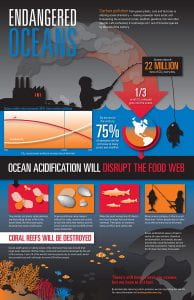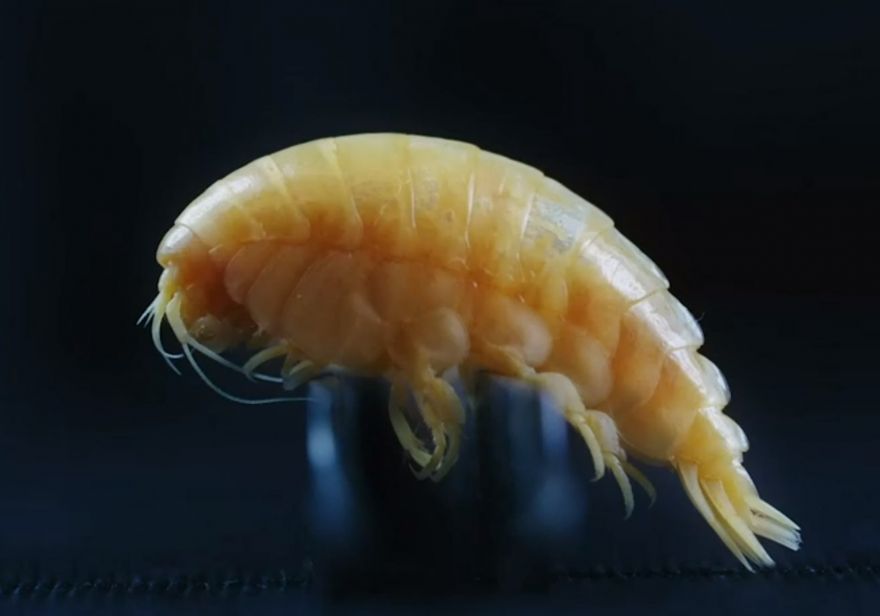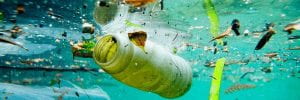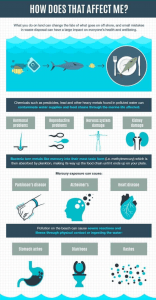Written by Kailyn Hayes, Edited by Skylar Griffin
Every single day, more and more waste is polluting our oceans. How can we stop this from happening if we don’t know the forms of pollution that take place? Even though we discussed the connection between life above and below the ocean surface, there is still more to know about the vast subject of ocean conservation. By learning about the types of ocean pollution, you are taking the necessary steps to help preserve over two-thirds of the planet.
One of the largest sources of marine pollution is called ‘nonpoint source pollution.’ Nonpoint source pollution occurs as an effect of runoff and includes sources, like vehicles, farms and septic tanks. Some forms of pollution that negatively impact the health of our oceans can come from a single source, such as oil spills, according to the National Oceanic and Atmospheric Association (NOAA). Nonetheless, after being contaminated by the pollution sources below, our ecosystems need a while to recover.

Types of Ocean Pollution
Oil – When you first hear about oil as an ocean pollutant, your mind more than likely conjures up images of a disastrous oil spill. However, oil from vehicles can also damage the ocean. The oil from vehicles on the road runoff and trickle into the ocean, according to National Geographic. Occasionally, boats will spill oil directly into the water. Regardless, oil seepage is harmful to marine life and it is our responsibility to reduce it.
Agricultural Runoff – Pesticides and nitrogen fertilizers that are used on land by farmers are carried into streams and rivers before eventually entering the ocean typically after heavy rain. NOAA states that 80% of marine pollution starts on land. For example, EPA Effects reported that runoff from the Mississippi River Basin is the cause of the “Dead Zone” in the Gulf of Mexico, which lacks a sufficient amount of marine life.
Industrial Waste – While rarely discussed, industrial waste is a huge issue when it comes to ocean dumping. Surprisingly enough, it wasn’t until the mid-1970s, that dumping industrial waste into oceans was illegal. Almost all large companies deal with toxic waste. This waste infects the water and sea life, including the ones we eat. Imagine getting mercury poisoning from eating sushi. Despite this being a rare occurrence, unless you’re obsessed and eat sushi every single day, the number of toxins entering the raw fish can have adverse effects on you as well.
Carbon Dioxide – Fossil fuel burning leads to the production of carbon dioxide, and the concentration of this gas speeds up our oceans becoming more acidic. This process changes the pH of ocean water and creates a devastating effect on shellfish and other marine life.

Plastic – One of the most common forms of ocean pollution is plastic. Whether it’s a plastic bag, a pack of straws or six-pack rings, plastic debris negatively affects our ocean. This trash can entangle and suffocate our oceanic friends. By reducing your use of plastic, you are helping the environment.
Now that you know the various forms of ocean pollution, you can go forward combating this issue. Go forward and spread more awareness about these different types of ocean pollution. In fact, as an Ocean Olympian, you can even challenge your friends to be mindful of their daily habits that affect our oceans.
 Throughout our time as humans living on the Earth, we have only discovered about 5% of the ocean. This leaves 95% of the ocean unexplored, as we are finding new species everyday. Most recently a species unearthed was named Eurythenes Plasticus…… sound familiar?
Throughout our time as humans living on the Earth, we have only discovered about 5% of the ocean. This leaves 95% of the ocean unexplored, as we are finding new species everyday. Most recently a species unearthed was named Eurythenes Plasticus…… sound familiar?  Eurythenes Plasticus is a new species of arthropod. It is a two inch shrimp-like animal found in the deepest trench on Earth- The Mariana Trench. The Mariana Trench reaches depths up to 36,000 ft as this new arthropod was found at a staggering 20,000 ft- This is crazy deep! Think of it this way: Mount Everest is the tallest mountain in the world reaching heights of 29,028 ft and the Mariana Trench is 36,000 ft!
Eurythenes Plasticus is a new species of arthropod. It is a two inch shrimp-like animal found in the deepest trench on Earth- The Mariana Trench. The Mariana Trench reaches depths up to 36,000 ft as this new arthropod was found at a staggering 20,000 ft- This is crazy deep! Think of it this way: Mount Everest is the tallest mountain in the world reaching heights of 29,028 ft and the Mariana Trench is 36,000 ft!




